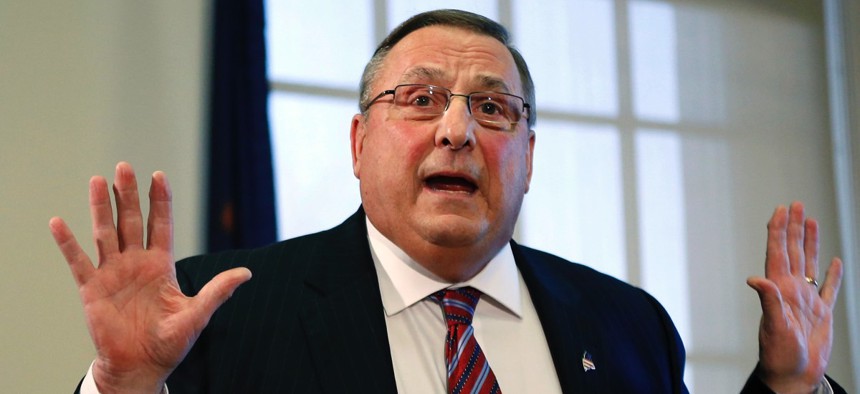Paul LePage's Binders Full of White People

(AP Photo / Robert F. Bukaty, File)
The Maine governor said blacks and Hispanics from out of state were to blame for drug problems, but his own files show mostly white Mainers being arrested for narcotics.
In August, Governor Paul LePage of Maine launched a diatribe at a man who’d asked him about a spate of drug problems in the state.
“I don’t ask them to come to Maine and sell their poison, but they come and I will tell you that 90-plus percent of those pictures in my book, and it’s a three-ringed binder, are black and Hispanic people from Waterbury, Connecticut, the Bronx and Brooklyn,” he said.
But when reporters asked to see the binder, LePage refused. It turns out he may have been right to be wary: Its contents, released Monday after an open-records request, showed that the Republican badly misstated its contents, blaming people of color from out of state when most of those included are white Mainers.
LePage, a Republican who has become nationally notorious for his repeated racist comments, said earlier this year that his state’s burgeoning drug problem was caused by “guys by the name D-Money, Smoothie, Shifty,” adding: “These type of guys that come from Connecticut and New York. They come up here, they sell their heroin, then they go back home. Incidentally, half the time they impregnate a young, white girl before they leave.”
LePage’s comments, which blamed people of color for Maine’s drug problem and included some old timey fearmongering about interracial relationships, were promptly and accurately labeled racist. As I noted at the time, there was little or no evidence to support his claim. He insisted it had nothing to do with race. But when he was asked about the claim in August, he changed course, saying that yes, it was about race, and it was people of color who were the problem.
That’s when he announced he had the binder in question. Reporters promptly asked to see the book. LePage refused. “Let me tell you something: Black people come up the highway and they kill Mainers. You ought to look into that!” he said, stomping away. “You make me so sick!” The American Civil Liberties Union of Maine and others filed a public-records request.
Now LePage’s binder full of (alleged) felons has been released. It’s a remarkable document for a variety of reasons. Reading the 148 pages, one gets a sense of the governor at work, gathering clips and messages that chronicle Maine’s drug epidemic, with a mix of mug shots, news clips, and bulletins about arrests. In several places, someone—presumably LePage—has annotated the notes in handwriting. On one page, for example, a note says, “why not federal charges US ATTORNEY.”
The most glaring takeaway, however, is the identities of those arrested. What they show is that LePage was almost entirely wrong in his characterization. It’s hard (and risky) to assign racial identities to every one of the people whose mugshots are included in the binder, but it’s clear that most of them are white. There are 93 people pictured. I counted slight more than 30 who appeared to be black or Hispanic; the Portland Press Herald calculated 37. That means at least 60 percent of them are white.
Nor does the idea that the drug trade is the fault of outsiders hold up. Setting aside the mugshots and tracking all of the arrests listed, there are more than 100 Mainers listed as being arrested for drug offenses, versus around 40 out-of-staters.
Unsurprisingly, Maine’s drug trade is mostly the product of Mainers, not people from Waterbury and the Bronx out to flood Vacationland with opioids. It is true that of the out-of-staters, a disproportionate number appear to be people of color, though it’s also unsurprising that in the whitest state in American, a higher proportion of non-residents would be non-white.
But even these numbers may very well overrepresent minorities. The names in the binder are generally people who were arrested, not convicted. And since people of color are arrested at higher rates for drug offenses than white people, even controlling for usage rates, the white share of the Maine drug trade is likely higher than LePage’s binder would suggest.
In summary, LePage not only vastly overestimated the portion of black and Hispanic faces in the collection, he incorrectly blamed people of color and out-of-staters for a problem that is largely created by white residents. Perhaps LePage simply misremembered and thought it was more black men, though given that he had ample time to check his figures, there would seem to be an subconscious tendency to blame black men. On the other hand, LePage’s list of greatest hits shows a consistent focus on race, including his assertion that President Obama hates white people and his refusal to attend Martin Luther King Day celebrations.
After LePage’s August outburst revealed the binder, a Democratic representative named Drew Gattine criticized the governor. LePage believed, apparently incorrectly, that Gattine had called him a racist, and called and left Gattine a profane and threatening voicemail. In the ensuing days, LePage mused aloud about resigning from office, and he offered a non-apology to Gattine, explaining that he was upset about being called a racist.
For the governor, being called a racist is worse than being a racist. But now that LePage’s attempt to pin culpability for Maine’s drug problems on black men from out of state have been debunked, will he apologize? Don't hold your breath. The Press Herald editorial board's apology to the rest of the United States for giving us LePage is likely to be the only mea culpa forthcoming.
David A. Graham is a staff writer at The Atlantic, where this article was originally published.
NEXT STORY: In 49 States, Income Boost Outpaces Economic Growth





